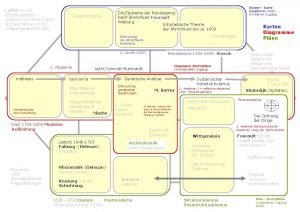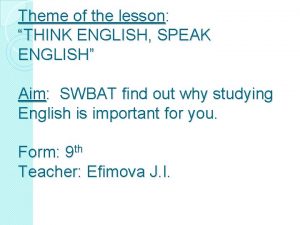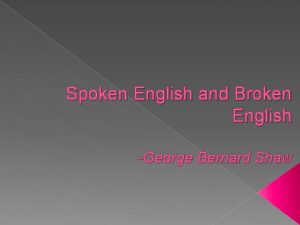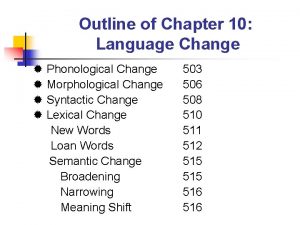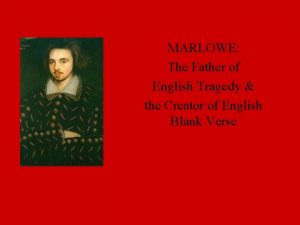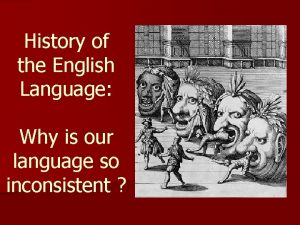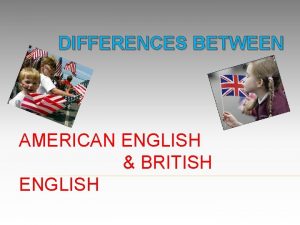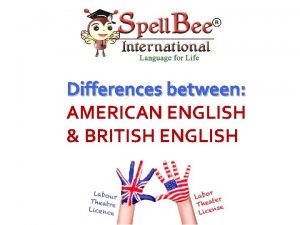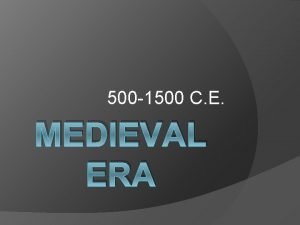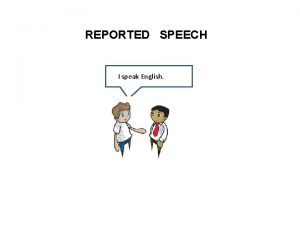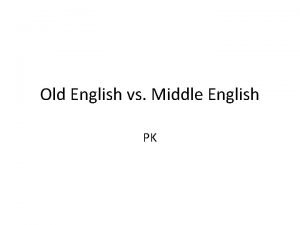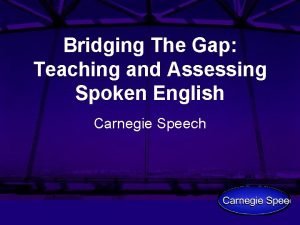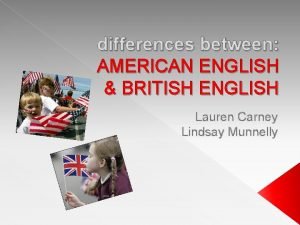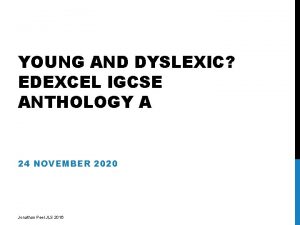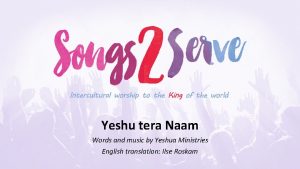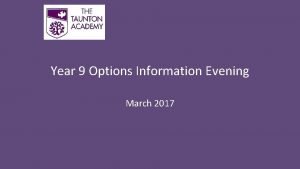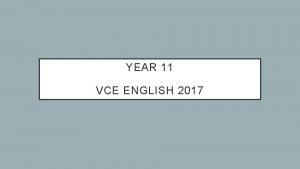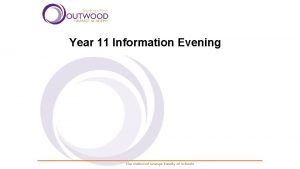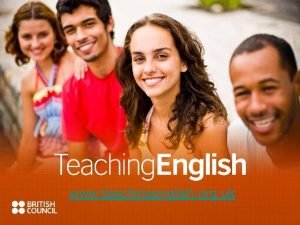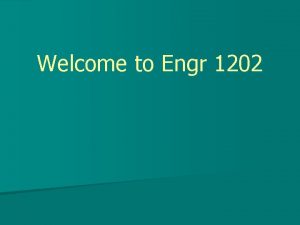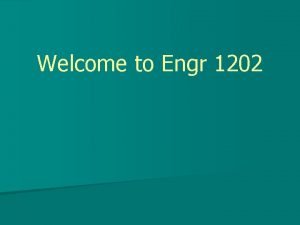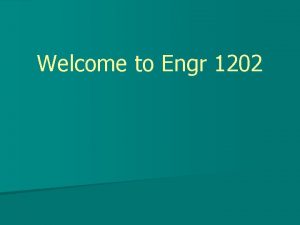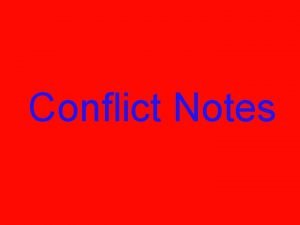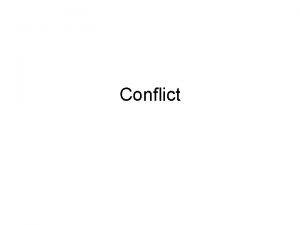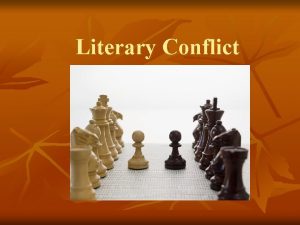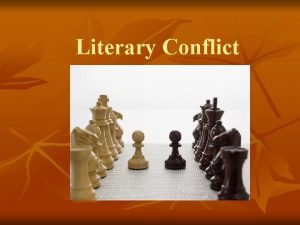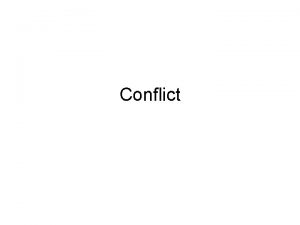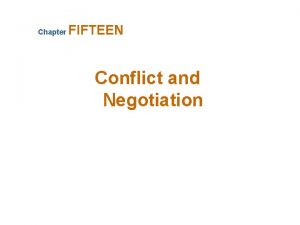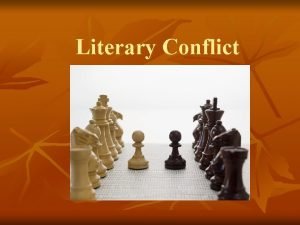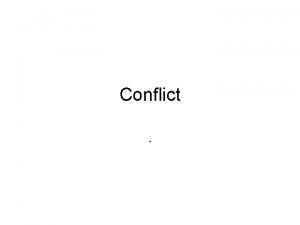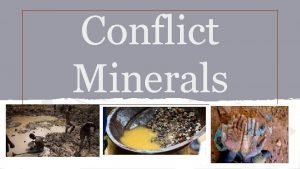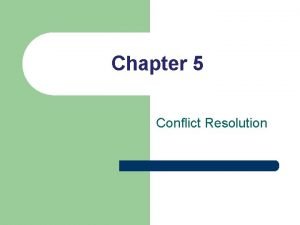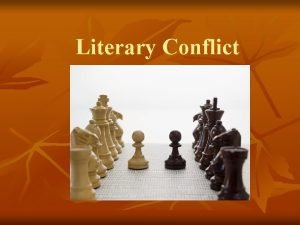Conflict English 1202 What is conflict A conflict


























- Slides: 26

Conflict English 1202

What is conflict? • A conflict, in simplest terms, is a fight between two things whether they are human or not.

What are the types of conflict? • • • Person versus Person (External) Person versus Society (External) Person versus Self (Internal) Person versus Nature (External) Person versus Technology (External) Etc.

Malala Yousafzai • Who is Malala Yousafzai? • Why is she famous? • Watch the Malala Yousafzai interview with Diane Sawyer and complete the Reading Response questions. • https: //www. youtube. com/watch? v=1 sa. Gtc. Dyd. BY

Free Write 7 -10 min Agree or disagree with one of the following statements and defend your reasoning. 1. Conflict is inevitable, but combat is optional. 2. People who fight fire with fire usually end up with ashes. 3. When angry, count to ten before you speak; if very angry, hundred. 4. Laughter is the shortest distance between two people.

Interpret Media Messages p. 46 -47 • Turn to the pages indicated in the textbook. • Using the information and questions on these two pages, analyze three visuals on the page. • Pay particular attention to the facial expressions and body language in the visual of the two girls. What can we infer (clues + prior knowledge = educated guess) about the two girls relationship?

“The Wolves Inside” p. 48 -49 • “Internal conflict is easier to cope with than external conflict. ” Agree/Disagree. Why? • What are some of the elements of a graphic story? • Handout of Graphic Terms/Concepts • Read through the selection then analyze the story using the questions/information from pages 46 -47. • In some texts, the black wolf and the grey wolf are represented as something else. What are they? • Symbolism: • What does the black wolf represent? • What does the grey wolf represent? • What color would have been a better choice for the grey wolf? Why?

Personal Pronouns • Subjects: I, me, my, mine, you, he, she, it, we, they Possessives • Objects: me, you, him, her, it, us, you, them • Possessives: my, mine, yours, his, hers, it, ours, yours, theirs

Personal Pronouns Practice What to Do • Write the correct personal pronoun in each of the sentences below. 1. I came to see you and _______ about cutting my lawn. (he/him) 2. Domenic and _______ will meet you there. (I/me) 3. Talk to _______ before you make a decision. (they/them) 4. A parcel came in the mail for _______ and _______ (he/him) (she/her) 5. It is _______ who voted “no. ” (they/them) 6. Tell Paul and _______ that Monica called. (she/her) 7. Max is as funny as _______ (he/him) 8. It is _______ who helped prepare the dinner. (we/us) 9. My friend and _______ will buy the snacks. (I/me) 10. Her brother weighs more than _______ (he/him)

Invictus Movie Poster • Use the questions/information found on page 46 -47 to analyze the movie poster. • Compare and contrast this poster to the visuals on page 46 -47. • Who and what is shown in this image? • What connections can you make to this text?

“One Team, One Country” p. 50 -51 • Define apartheid • Apartheid: An Afrikaans word meaning “the state of being apart, ” literally “apart-hood” • South African facts • • • Legal system of segregation in South Africa 1948 -1994 African, Asian, and mixed-raced population forced to live in separate locations Africans lost their national citizenship Police given powers to arrest and punish lawbreakers severely Best land reserved for white population Nelson Mandala jailed for 27 years for opposing apartheid

“One Team, One Country” (continued) • Read the selection • Analyze the selection using the information/questions on page 46 -47. • Discuss the following: • • What predictions can you make about the selection based on this information? What is your eye drawn to first? How has the photographer made these images stand out? How is colour used in these photos? What effect does it have on you? How is this image of Mandela linked to the image of the rugby players? What message does it send? What message does this image send on page 52 -53? How do you respond to that message? What is the purpose of the image on page 52 -53? What story does this image tell on page 52 -53? Do the players’ arms suggest a shape? What might the shape stand for? (p. 52 -53)

What are the types of connections? (p. 4) • Text-Self: When you connect what you are reading, viewing, and or listening to something involving your own life and prior knowledge. • Text-Text: When you connect what you are reading, viewing, and listening to another text that you already have previous knowledge about. • Text-World: When you connect what you are reading, viewing, and listening to the world at large. Example: Among the Hidden by Margaret Haddix involves a two child policy. This can be connected to China’s one child policy.

Inferences (p. 5) • Clues + Prior Knowledge = Assumption or Judgement

“The Trickster” p. 5 -11 • Listen to the audio text or read independently for this selection. • Complete the Reading Response for this selection. • Using the Elements of a Short Story handout, discuss/point out the main elements of “The Trickster” to students so that they can establish a link between the definition and the example. • Continuing using the handout, have students apply their knowledge of figurative language techniques by pulling out various examples from the text.

What is the figurative language device? • P. 6 “Finding the resource centre in the corridors of the science building was like trying to find a tiny piece of cheese in a maze. ” • P. 6 “Maybe this wouldn’t be a wasted afternoon after all. ” • P. 6 “Something small, grey-white, and pointed rolled across the counter. ” • P. 7 “There was something tight and coiled up about them. ” • P. 9 “A screech of tires drew Josh’s attention to the window again” • Page 7, Paragraph 6 “OK, so that last bit …”

“Canadian January Night” p. 19 • Read through the poem. • Going line through line as needed, determine the actual meaning of the various elements of the poem. • Infer what is meant by black crystal and pyramid. • Complete the Reading Response handout for this poem.

“Scars” p. 24 -33 • What are the elements of a short story? • “How you handle conflict with others defines your relationship with them. ” • Using the following words, separate the words into four columns (Characters, Setting, Problem, Outcomes). • father, old vehicles, axe, brother, field, disease, hospital, accident, glasses, fear, Daniel, I was crying, parking lot, mother, something breaking, dead • Using the words, write a statement predicting what the text is going to be about.

“Scars” (continued) • As the story is played, fill out the handout provided. • . . DocumentsScars by Don Aker. docx • Choose one of the following to complete • Storyboard – Create eight scenes depicting what happened in the story. Be creative and use color. • Write a story titled “Scars. ” This may be a personal narrative about how you got a particular scar of fictional one. Minimum one page.

“The Hockey Sweater” • Free write 7 -10 min. Why is hockey considered “Canada’s game”? Make sure to support your answer with a personal connection and any prior knowledge about the sport you know. • Make connections (T-S, T-T, T-W) to the sport of hockey. • Who is your favorite team? Why? • Which hockey team do you think is better – Toronto or Montreal? • How would you feel if you were forced to wear the wrong team’s jersey/sweater? • Watch or read the short story “The Hockey Sweater” • https: //www. youtube. com/watch? v=Egydkfn. UEi 8 • http: //resource 2. rockyview. ab. ca/ela 201/related_read/passions/hockey_sweater. pdf • Students are to continue to analyze the elements of a short story – character (focus on clues that provide hints about personality), plot, theme/message, point of view, conflict (+evidence in text), and literary devices (allusion, simile).

“Dulce et Decorum Est” p. 60 -61 • Statements – Agree or Disagree with the following • • • Wars are good for the economy Wars build patriotism, which is good for morale. Only professional soldiers are killed in war. Citizens have a duty to defend their country. The number of people killed or wounded in WWI was not a large number.

“Dulce et Decorum Est” (continued) • Title translations • It is a sweet and fitting thing. • It is glorious and honourable. • • • Based on the title what is this selection going to be about? How is this poem organized? What is the purpose of this poem? Who is the audience of the poem? What is theme/message of the poem? Provide two references to the text and explain. • What connections can you make?

“Dulce et Decorum Est” (continued) • Read through and locate as many literary devices as you can? (Hint: there are three different types) • Answer the Developing Ideas, Organizing Ideas, and Critical Literacy questions located on page 61 using the formula below • Title of piece • Author’s Name • Define literary term if there is one • Answer the question • Quote for support • Connect quote to answer • Repeat steps 5&6 if asked. • Concluding sentence

“Focus on Listening and Speaking” pp. 62 -63 • Read over the concepts provided on the two pages. • Listen to a reading of several differing paragraphs and analyze which elements of listening and speaking are being used. • BLM 13*

“Conflict” pp. 64 -67 • Elements of a script: characters, action/stage direction, scene heading, dialogue, extension, parenthetical, transition, shot, dual dialogue, act/scene number, cast list • Free write 5 -7 min: Life is dull without conflict. Agree or disagree and provide two reasons with examples of your choice. • Use the prompts to analyze the script. • Analogy p. 67: What is an analogy? What is the analogy found on page 67? How does the analogy help you understand conflict? • Answer the questions on page 67.

Short Story Test • You will be reading and writing a short story test to finish of this unit.
 Delta flight 1202
Delta flight 1202 +1202
+1202 Design and fabrication 1202
Design and fabrication 1202 Think english speak english
Think english speak english Spoken english and broken english g.b. shaw summary
Spoken english and broken english g.b. shaw summary Semantic change
Semantic change Who is called the father of english tragedy
Who is called the father of english tragedy Old english vs modern english
Old english vs modern english Motorway in american english
Motorway in american english American british word differences
American british word differences Old english vs modern english
Old english vs modern english Do you speak english reported speech
Do you speak english reported speech 2000 in old english
2000 in old english The gap between written and spoken english
The gap between written and spoken english Types of english
Types of english A struggle between a character and an outside force
A struggle between a character and an outside force What is conflict and conflict resolution?
What is conflict and conflict resolution? External conflict definition
External conflict definition Ziarat hazrat abbas in english
Ziarat hazrat abbas in english Jamaican english
Jamaican english Young and dyslexic language features
Young and dyslexic language features Uzima wa milele in english
Uzima wa milele in english Jis naam me hai mukti lyrics
Jis naam me hai mukti lyrics English baccalaureate
English baccalaureate Vcaa english exam 2017
Vcaa english exam 2017 Outwood english revision
Outwood english revision Https://project.teachingenglish.org.uk
Https://project.teachingenglish.org.uk

